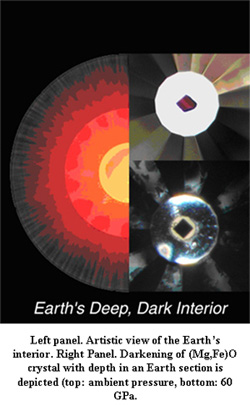 The flow of heat in Earths deep interior plays an important role in the dynamics, structure, and evolution of the planet. Heat from the very hot core can flow outward by convection, radiation, and conduction. The relative amount of heat flow from these mechanisms is currently under debate. Experiments performed at the Carnegie Institution's Geophysical Laboratory in facilities supported by CDAC show that the radiative component of thermal conductivity in (Mg,Fe)O is reduced upon reaching the low-spin state. The team consisting of Alexander Goncharov, Viktor Struzhkin, and Steven Jacobsen subjected single crystals of (Mg,FeO) to pressures exceeding 60 GPa and measured optical spectra in a wide spectral range. In contrast to prevailing notions, they observed enhanced absorption in the mid- and near infrared spectral range, effectively blocking much of the light compared with low pressure conditions. The notion of reduced radiative heat transfer in low-spin phases challenges existing theories on superplume stability in the lower mantle, which appears to require high thermal conductivities in order to mitigate huge temperature gradients calculated for the case of constant thermal conductivity. This work also gives a new insight into the interpretation of the optical spectra of this important oxide containing a transition metal. This research appears in the May 26, 2006 issue of Science.
The flow of heat in Earths deep interior plays an important role in the dynamics, structure, and evolution of the planet. Heat from the very hot core can flow outward by convection, radiation, and conduction. The relative amount of heat flow from these mechanisms is currently under debate. Experiments performed at the Carnegie Institution's Geophysical Laboratory in facilities supported by CDAC show that the radiative component of thermal conductivity in (Mg,Fe)O is reduced upon reaching the low-spin state. The team consisting of Alexander Goncharov, Viktor Struzhkin, and Steven Jacobsen subjected single crystals of (Mg,FeO) to pressures exceeding 60 GPa and measured optical spectra in a wide spectral range. In contrast to prevailing notions, they observed enhanced absorption in the mid- and near infrared spectral range, effectively blocking much of the light compared with low pressure conditions. The notion of reduced radiative heat transfer in low-spin phases challenges existing theories on superplume stability in the lower mantle, which appears to require high thermal conductivities in order to mitigate huge temperature gradients calculated for the case of constant thermal conductivity. This work also gives a new insight into the interpretation of the optical spectra of this important oxide containing a transition metal. This research appears in the May 26, 2006 issue of Science.
